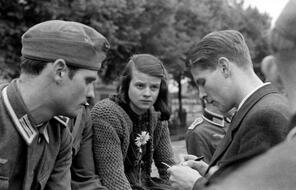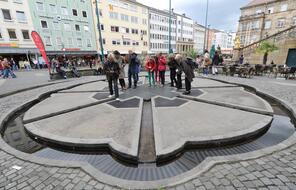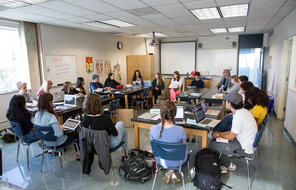“Celebrating Purim in the Bizerte Camp (1942-1943)”
Subject
- History
- Social Studies
Language
English — USUpdated
Tunisia was directly occupied by the Germans between November 1942 and May 1943. While the 85,000 Jews of Tunisia had already been targeted by Vichy antisemitic laws during the direct Nazi occupation, their situation worsened. Jews were increasingly arrested, publicly humiliated, and the community as a whole was heavily taxed. The Nazis also assigned Jewish men to forced labor, and some Tunisian Jews were deported to camps in Europe.
Jacob André Guez was one of almost 5,000 Jews who were sent to labor camps in Tunisia, where prisoners died from disease, hard labor, and torture, as well as from Allied bombings. In December 1942, Jacob was twenty-four years old when he was imprisoned in a camp near the city of Bizerte, and, during his internment, he recorded notes about daily life in the camp on loose bits of paper. Later, he collected those notes into a diary that he published in 2001.
In the diary, Guez shares about the conditions in the camp, including the oppressive work regimen, the unsanitary conditions, and the violence the German guards consistently inflicted upon the prisoners. Even in these conditions, Guez also reflects on moments of relief, including the following description of a celebration of the Jewish holiday of Purim. 1
Jacob André Guez in Bizerte Camp, Tunisia:
They sleep like sardines, squashed one against another, on straw that has not been changed since their arrival. They cannot even take their clothing off at night, due as much to the bombings as to the need to stay warm in these vast, bare rooms whose window panes are broken and whose doors have been blown out by explosions, and also so that they are not robbed because the penury is such that people commonly steal clothes and food. They are all covered in vermin: you can hardly think of seriously cleaning yourself when you know that there are only three sinks for the camp’s 1,400 men. . . .
Purim is tomorrow, and the festivities will begin this evening. Young Rabbi Assuied, in a barracks room, reads us the megillah, the story of Esther, Mordechai and Ahasuerus. As the night falls, echoes of the celebration ring out. A guy comes out with a drum that he nicked from some barracks. He wanders about the camp, striking it like a deaf man: a crowd of laborers follow him, shouting out and dancing . . . One Jew rushes over with a darbouka 2 , taken from who knows where. Others tap on bowls with spoons, adding to the cacophony and the confusion. . . .
Frenzied line dances in the moonlight, frenetic dances, all the resentment and bitterness are pushed away, far, far into the bottom of our hearts. Hope, the immense strength of the Jews, fills our chests. In the midst of captivity, cries of joy rise up towards heaven in memory of our liberation, centuries ago, in memory of the fall of evil men. Even with nothing, the Jews will celebrate Purim! . . .
We return and lay down, having lost our voices. Rain starts to fall. We won’t even miss the traditional Purim firecrackers. The DCA [Défense contre les aéronefs, or air defense] replaces them: airplanes attack the large, broken down cargo ships that arrived today near La Pêcherie. It’s rare, a bombing in the middle of a diluvian rainstorm. 3
- 1Purim is a holiday that celebrates a story in which the Jewish people survived a threatened massacre in Persia that was planned by the royal advisor, Haman. The story is recounted from a scroll called the Megillah, and it tells how Esther—a Jew who became queen—and her uncle Mordechai, courageously took the steps necessary to expose the plot to King Ahasverus, inspiring his intervention.
- 2A goblet-shaped drum.
- 3Stein, Sarah Abrevaya, and Aomar Boum. “Guez, Jacob André. Au camp de Bizerte: Journal d’un juif tunisien interné sous l’Occupation allemande, 1942–1943. Collection Mémoires du XXe siècle (Paris: L’Harmattan, 2001). Translated from French by Rebecca Glasberg.” Essay in Wartime North Africa: A Documentary History, 1934–1950 (Stanford, CA: Stanford University Press, 2022), 204.
How to Cite This Reading
Facing History & Ourselves, ““Celebrating Purim in the Bizerte Camp (1942-1943)” ”, last updated June 30, 2023.









